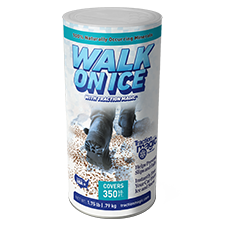5 Effective Techniques To Remove Tire Marks From Concrete

Safe Ice Melt for Concrete: 5 Effective Techniques to Remove Tire Marks from Concrete
Concrete driveways are durable, but they aren’t immune to unsightly tire marks. These marks, caused by the transfer of rubber compounds, can be tough to remove without the right tools and techniques. This guide explores effective ways to eliminate tire marks, preventative measures to protect your driveway, and long-term maintenance tips to keep your concrete surfaces pristine.
The sight of unsightly tire marks on your pristine concrete driveway or garage can be a cause for concern. Over time, rubber tires can leave black streaks and imprints, detracting from the overall look of your property. You may find yourself wondering how to get tire marks off concrete or how to remove tire marks from concrete without causing any damage. Luckily, there are several effective methods available that can help you restore the appearance of your concrete surfaces. Here are five techniques that you can use:
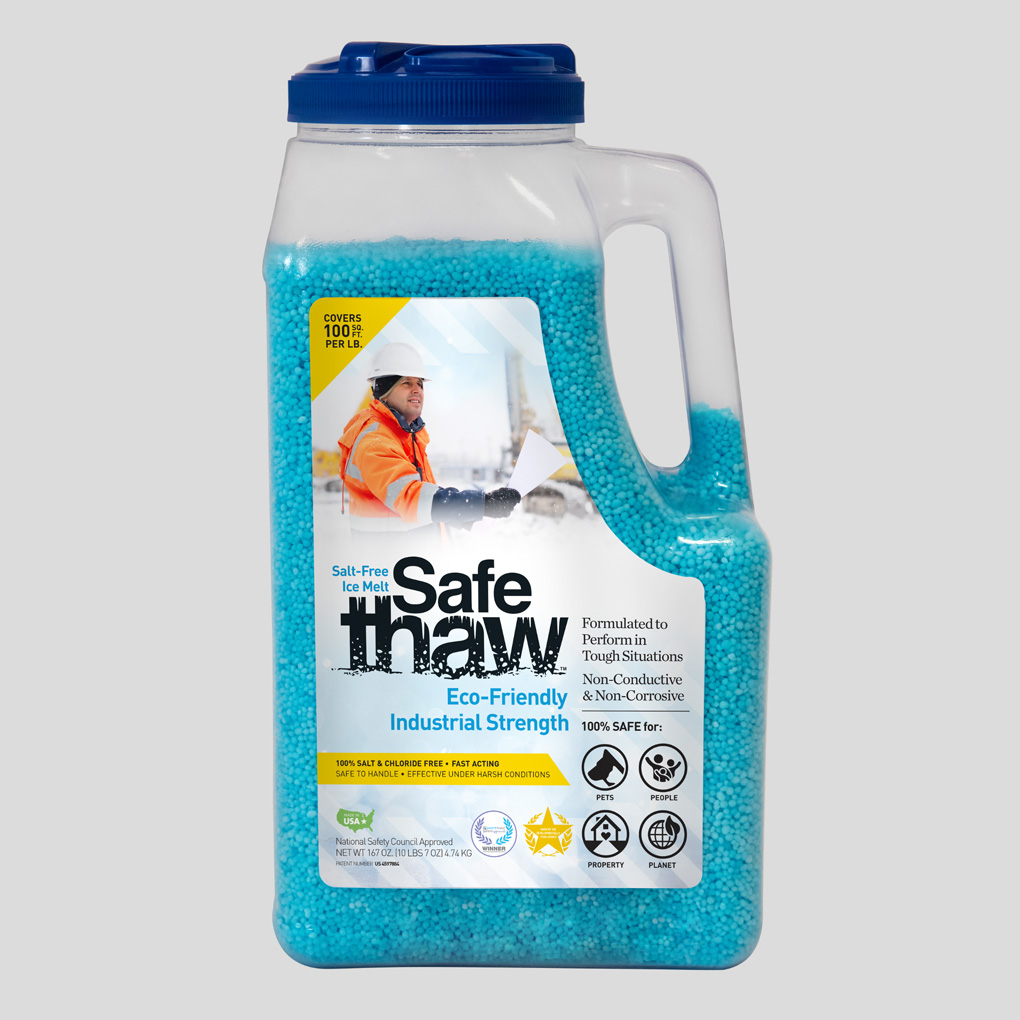
Safe Thaw
Safe Thaw was created as the ice management solution for tough winter environments. Ideal in commercial and industrial properties, shops, government agencies, bridges, and construction.
How To Get Tire Marks Off Concrete
1. Simple Soap And Water
Before diving into more complex methods, starting with the basics is always a good idea.
Steps:
- Fill a bucket with warm water and add a few drops of dish soap.
- Using a scrub brush, scrub the tire marks vigorously.
- Rinse the area with clean water and let it dry.
2. Baking Soda Solution
Baking soda is a gentle abrasive and natural cleaner which can be effective in removing tire marks without damaging the concrete surface.
Steps:
- Make a paste by combining baking soda with water.
- Apply the paste to the tire marks and scrub using a brush. The slight abrasive nature of baking soda can help lift the marks.
- Rinse thoroughly with water.
3. Commercial Cleaners And Degreasers
There are many commercial cleaners designed specifically for concrete surfaces that can help in removing stubborn tire marks.
Steps:
- Select a cleaner that’s designed for concrete surfaces.
- Follow the instructions on the label. Typically, you’ll need to apply the cleaner, let it sit for a specific time, then scrub and rinse.
- Ensure the area is well-ventilated if using a strong cleaner or degreaser.
4. Power Washing
For those tire marks that just won’t budge, using a power washer can be a solution. This method uses a high-pressure stream of water to remove dirt and stains from surfaces.
Steps:
- Start by setting your power washer to a low setting to avoid any potential damage.
- Aim the washer at the tire marks and gradually increase pressure until the marks start to fade.
- Make sure to keep the nozzle moving to prevent etching or damage to the concrete.
5. Safe Thaw: An Unexpected Solution
While Safe Thaw is primarily designed as a chemical and toxin-free ice melt, its granular nature can provide a gentle abrasive effect, making it effective for scrubbing away tire marks.
Steps:
- Sprinkle a small amount of Safe Thaw over the tire marks.
- Use a scrub brush to scrub the area.
- The granules will provide additional scrubbing power, helping to lift the tire marks.
- Rinse the area thoroughly with clean water once done.
Important Tips To Remember
- Always test any cleaning method on a small, inconspicuous area first to ensure it doesn’t cause any damage or discoloration.
- When using chemicals or commercial cleaners, ensure proper ventilation and wear protective gloves.
- Regularly cleaning and sealing your concrete can prevent tire marks from setting in deeply, making them easier to remove in the future.
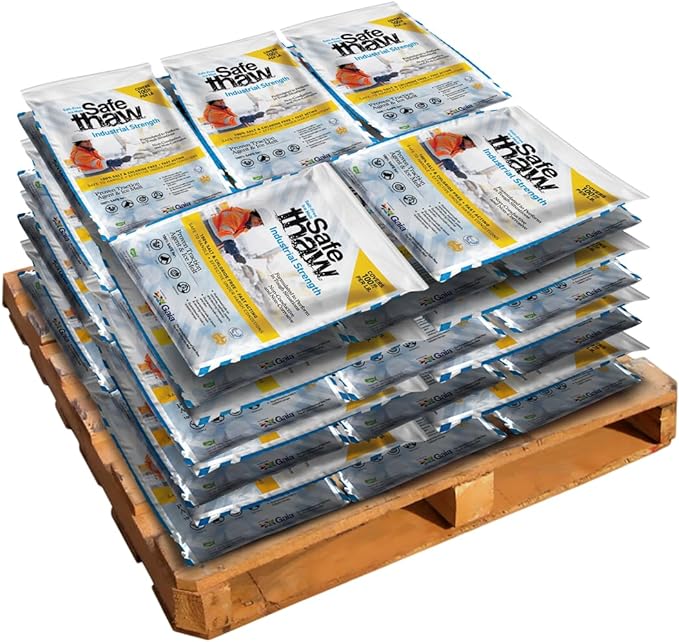
40 Bags
Safe Paw Thaw Industrial Strength Salt-Free Pet Safe Snow Ice Melter and Traction Agent for Concrete, Asphalt, Decks, Lawns, and More, 43 Pound Bag- 40 Bags
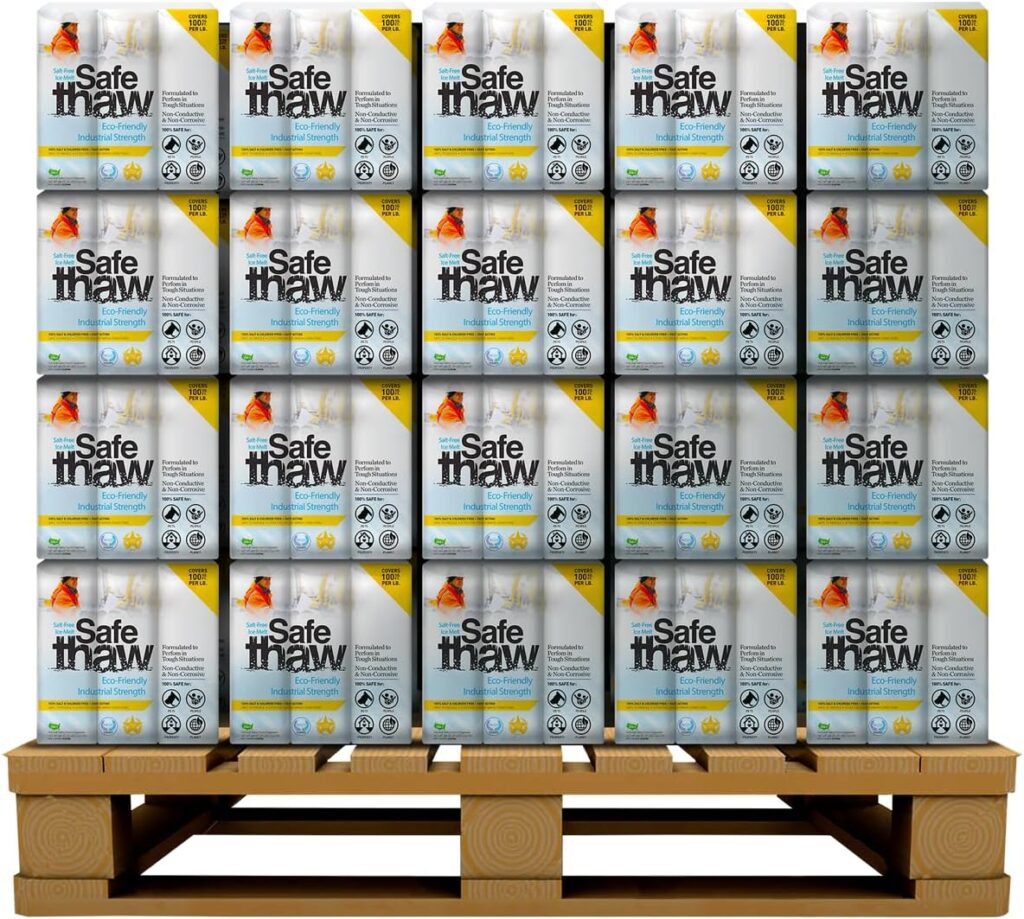
100 Boxes
Safe Thaw Industrial Strength 100% Salt/Chloride-Free, Pet/Paw-Safe Snow & Ice Melter and Traction Agent. Use on Concrete, Asphalt, Roofs & On Any Surface, 30 Pound FlexiPail- 100 Boxes
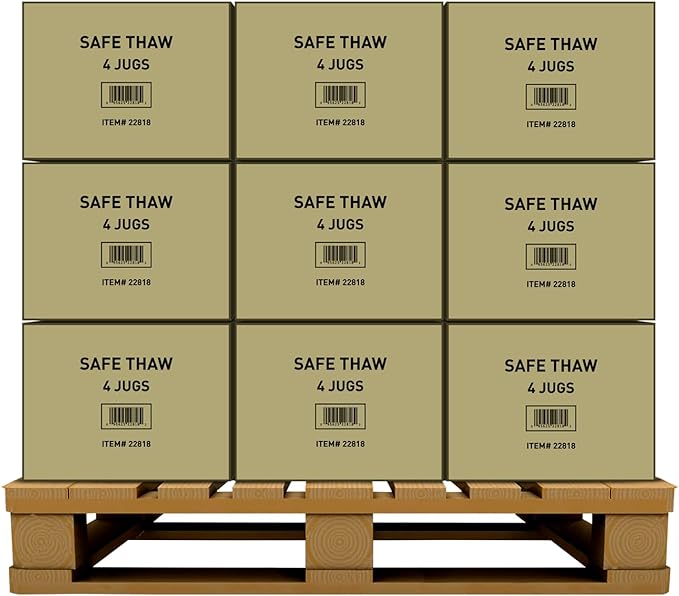
105 Jugs
Safe Thaw Concrete Safe 100% Salt-Free, Pet Safe Snow and ice Melter, Industrial Strength, Chloride-Free, and Traction Agent. Use on Asphalt, Roofs & On Any Surface, 10 Pound Jug- 105 Jugs
Preventative Measures to Avoid Tire Marks
Preventing tire marks is the first step to maintaining a clean and durable concrete driveway.
Apply a Concrete Sealer
Using a high-quality concrete sealer creates a protective barrier that prevents rubber compounds from penetrating the surface. Sealers make it easier to clean future stains and protect against moisture, deicing chemicals, and other contaminants. Reapply sealant every two to three years for optimal protection.
Use Protective Mats in High-Traffic Areas
Placing mats or rubber runners in areas where vehicles are frequently parked can reduce direct contact between tires and concrete. This is especially beneficial for garages or driveways with heavy use.
Maintain Proper Tire Pressure
Overinflated tires can create more friction and heat, increasing the likelihood of rubber transfer onto concrete. Regularly checking and maintaining proper tire pressure minimizes this risk.
Environmental and Safety Considerations
Choosing the right cleaning agents is essential for preserving your concrete and minimizing environmental impact.
The Impact of Harsh Chemicals
Many commercial cleaning agents contain harsh chemicals that can harm surrounding vegetation, soil, and water sources. These products may also degrade the integrity of your concrete over time.
Opt for Eco-Friendly Solutions
Eco-friendly cleaners, such as biodegradable degreasers or vinegar-based solutions, are effective alternatives that reduce environmental harm. These products safely break down tire marks without introducing harmful residues into the ecosystem.
When cleaning, always follow the manufacturer’s guidelines and ensure proper ventilation if using chemical-based solutions indoors.
100% salt & chloride-free, fast acting Ice Management Solution
Comparative Analysis of Cleaning Methods
Removing tire marks can be done using a variety of techniques, each with its own benefits and drawbacks.
Household Remedies
- Baking Soda and Water: Create a paste and scrub the tire marks using a stiff-bristled brush. This method is cost-effective but requires significant elbow grease.
- Vinegar and Dish Soap: A mixture of vinegar and dish soap can effectively break down rubber compounds. While eco-friendly, this method may need multiple applications for stubborn stains.
Commercial Cleaners
- Degreasers: Products like Simple Green are specifically designed to cut through tough grease and rubber marks. They are more effective than household remedies but come at a higher cost.
- Pressure Washing: A high-pressure washer removes marks quickly but requires careful handling to avoid damaging unsealed concrete.
Mechanical Methods
- Power Scrubbers: These machines use rotating brushes to clean the surface effectively. While efficient, they may be costly and unnecessary for small-scale cleaning needs.
Choosing the right method depends on the severity of the tire marks, your budget, and environmental considerations.
Long-Term Maintenance Practices
Maintaining your concrete driveway regularly can prevent the recurrence of tire marks and extend its lifespan.
Regular Cleaning Schedule
Establishing a routine cleaning schedule helps prevent the buildup of stains, dirt, and grime. Clean your driveway every few weeks using mild soap and water to keep it looking fresh.
Address Stains Promptly
Tackle tire marks as soon as they appear. Fresh stains are easier to remove and less likely to penetrate the concrete surface.
Use Safe Ice Melt for Concrete in Winter
During winter, ice and snow can lead to additional wear on concrete surfaces. Using safe ice melt for concrete, such as Safe Thaw, prevents damage while maintaining a clean surface. Chloride-free and non-corrosive options ensure that your driveway stays intact throughout the season.
Avoid Overloading the Surface
Heavy vehicles or prolonged parking in one spot can create heat and pressure that lead to tire marks. Distribute weight evenly by rotating parking spots or using protective mats.
Concrete Driveway Costs and Maintenance
Investing in a concrete driveway is a long-term decision. The concrete driveway cost varies based on size, location, and finish, ranging from $5 to $15 per square foot. Protecting this investment with regular maintenance and eco-friendly practices minimizes additional expenses over time.
Do Driveway Tires Marks Go Away Naturally?
Now, here’s something a lot of homeowners wonder after scrubbing away at concrete—do tire marks on driveway go away if you just leave them? Sadly, not really. Sure, rain and sunlight may soften the look a bit, but those black streaks from hot rubber don’t just vanish. They settle deep into the pores of your concrete, which is why you can still see faint outlines weeks later.
What actually happens is that dust, dirt, and grime start blending with the rubber, making the marks look a little lighter. But don’t be fooled—it’s still there. The truth is, tire mark removal concrete cleaning works best if you catch it early before the rubber bonds fully. Waiting it out only makes your next cleaning session tougher.
How To Get Black Tire Marks Off Driveway Without Damaging It
So, if time doesn’t solve the problem, the next question becomes—how to get black tire marks off driveway without scratching or weakening it? The trick is starting gentle and stepping it up only when needed.
- A mix of warm water and dish soap with a stiff brush often clears light marks.
- For medium streaks, baking soda paste or a vinegar-and-soap scrub gives extra lift.
- When the black lines are stubborn, eco-friendly degreasers granules used as a mild abrasive can break the bond without harming the surface.
The big mistake? Using harsh chemicals or overdoing pressure washing. That can etch the surface, leaving permanent rough spots that collect even more grime. A careful rinse after scrubbing is just as important, so residue doesn’t leave its own stains behind.
Tire Mark Removal Concrete: Habits That Keep Marks From Coming Back
Of course, it’s not just about cleaning once—it’s about keeping those marks from returning so quickly. That’s where simple tire mark removal concrete habits come in handy.
- Seal your driveway every couple of years. A good sealant makes concrete less porous, so rubber has a harder time sticking.
- Switch up parking spots once in a while. It evens out the pressure and heat on the surface.
- Use garage mats if your car sits in one place for long stretches.
- Check tire pressure regularly. Overinflated tires generate more heat and friction, which means more rubber residue.
Think of it like this: the less your tires bond to the concrete, the less scrubbing you’ll be stuck with later.
Do Winter Conditions Make Tire Marks Worse?
Funny enough, yes—winter can make the problem worse. When your tires are coated with slush, road salt, and debris, all of that gets ground into the driveway surface as you park. The result? Darker, stickier streaks that are tougher to clean.
That’s why your choice of ice melt actually matters here. Using a chloride-based product may not only eat away at your concrete but also mix with rubber residue, creating ugly stains. Switching to a safe, chloride-free ice melt means you’re protecting your driveway from both cracks and discoloration at the same time. It’s a small change with a big payoff.
Conclusion
Tire marks may look harmless at first, but they quickly build up and take away from the clean finish of your driveway. And no—do tire marks on driveway go away naturally? They don’t. That’s why knowing how to get black tire marks off driveway and keeping up with smart tire mark removal concrete habits makes all the difference.
Early cleaning, protective sealing, and safer winter maintenance products are the three things that will keep your driveway looking sharp for years. After all, your driveway isn’t just concrete—it’s one of the first things people notice about your home. Keeping it stain-free means keeping that first impression strong.
Try Also Our Other Winter Safety Products:
Safe Paw
The Original and #1 Selling Pet and Child Safe Ice Melt for over 20 years. Guaranteed environmentally safe –It won’t harm animals or children, and it won’t damage your property. That’s Safe Paw. Safe Paw can change how winter affects our planet.

Walk On Ice
The handy disposable canister can be taken everywhere, with the same 100% naturally occurring minerals that provide instant traction on ice or snow. Use it on sidewalks, steps, or as an instant traction agent for your car.
